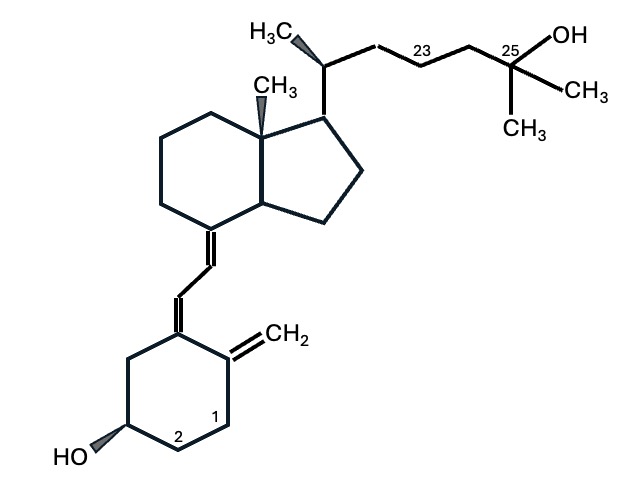Calcifediol
By Jens Allmer
The name Calcifediol (aka vitamin D) refers to a hormone that is produced via hydroxylation of Cholecalciferol in the human liver. Calcifediol is typically bound to the D-binding protein (DBP) but can be unbound if there is not enough DBP. If unbound, it is typically degraded and excreted via the kidneys. When bound to DBP, Calcifediol is relatively stable and can circulate in the human blood for weeks. Unless it is converted to Calcitriol and used by downstream processes. If demand for Calcitriol is high, e.g., low calcium or challenges to the immune system, ‘stored’ Calcifediol is converted to Calcitriol quicker.
 Chemical structure of Calcifediol
Chemical structure of Calcifediol
Chemical structure of Calcifediol. Calcifediol has a hydroxy group in position 25 where Cholecalciferol only has a hydrogen atom. This conversion typically happens in the human liver. Muscle cells can also perform this conversion, though.
| Study | ng/ml | nmol/L | Interpretation |
| Guidelines | <12 | <30 | Severe deficiency |
| Guidelines | 12-20 | 30-50 | Deficiency |
| Guidelines | 20-30 | 50-75 | Insufficiency |
| Guidelines | 30-50 | 75-125 | Sufficiency |
| Guidelines | >50 | >125 | Excess? |
| Jones 2008 | <100 | <250 | Likely safe. |
| Judson et al. 2001 Sommerville |
100-140 | 250-350 | optimal |
Guidelines for Calcifediol levels in the blood and their clinical interpretation. Alternative explanations are given in the cited studies. The guidelines assume toxicity above 50 ng/ml. I personally side with the studies below and other studies that show higher blood levels without toxicity.
Calcifediol levels don’t refer to the active form of the hormone which is Calcitriol. However, with low levels of Calcifediol, the conversion to Calcitriol may be hampered, and the resulting levels of Calcitriol will also be low. Hence, Calcifediol is a good marker for the sufficiency of vitamin D in the human body.
In addition to Calcifediol, Calcitriol should also be measured in diseases where the conversion from calcifediol to Calcitriol is out of control. Examples are sarcoidosis, where too much Calcitriol is produced, and conditions like chronic kidney disease, where the conversion to calcitriol is often hampered, leading to lower levels of the active form of vitamin D.
